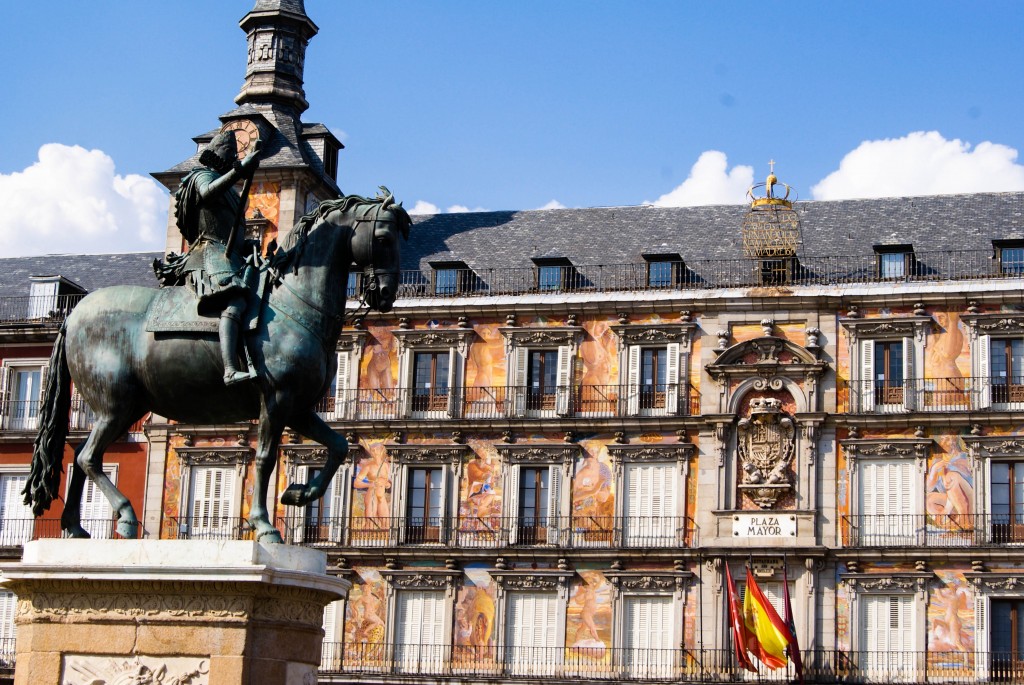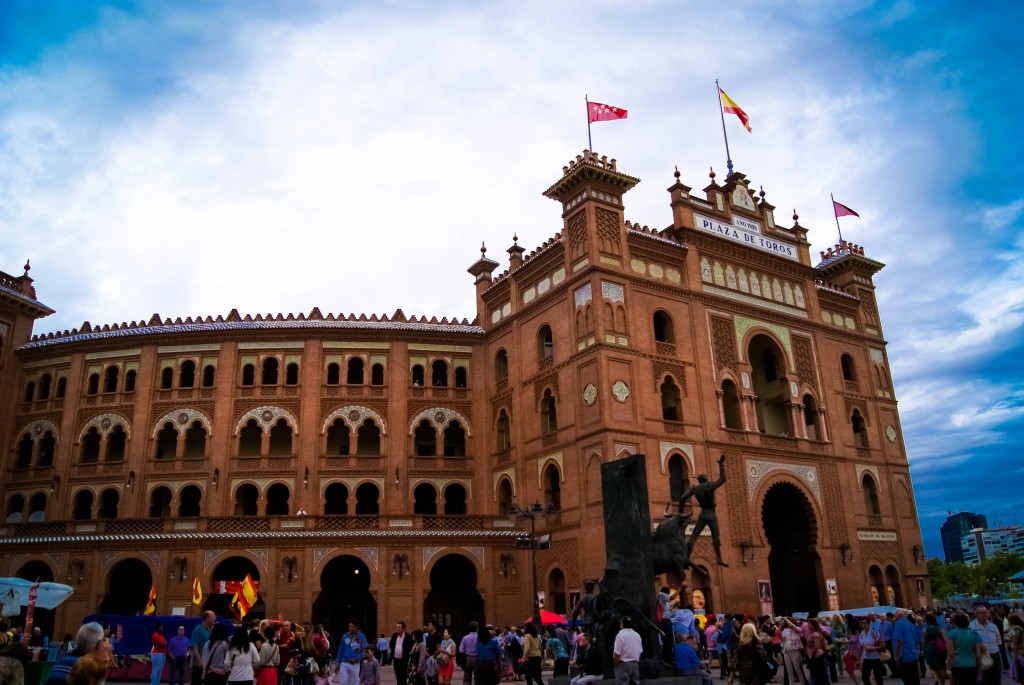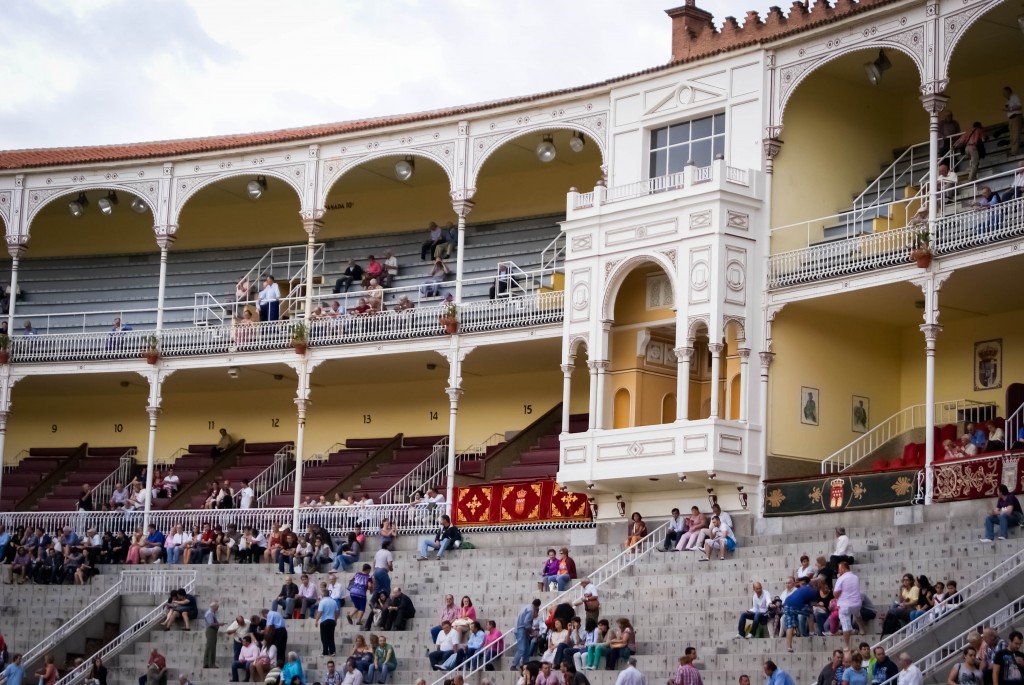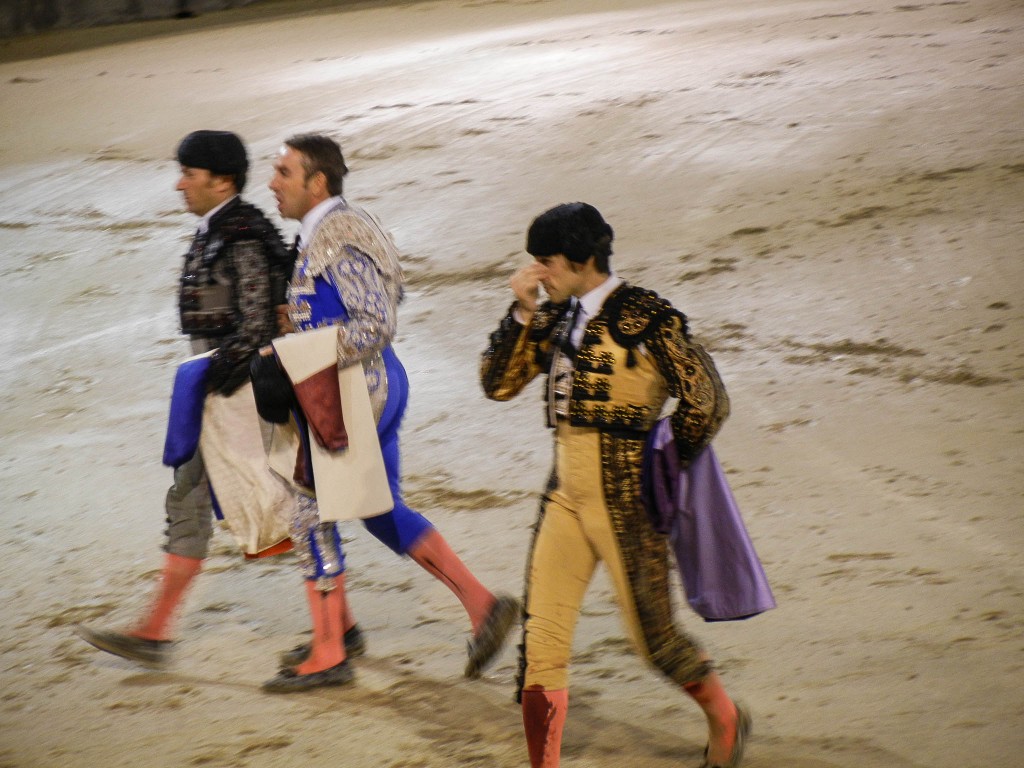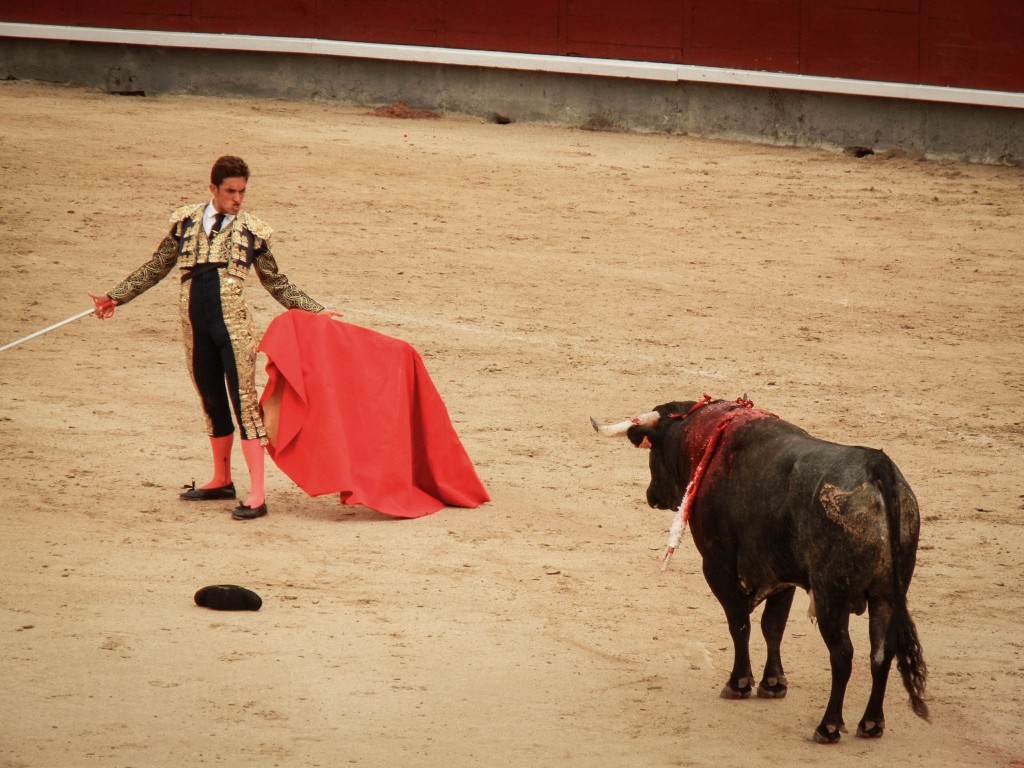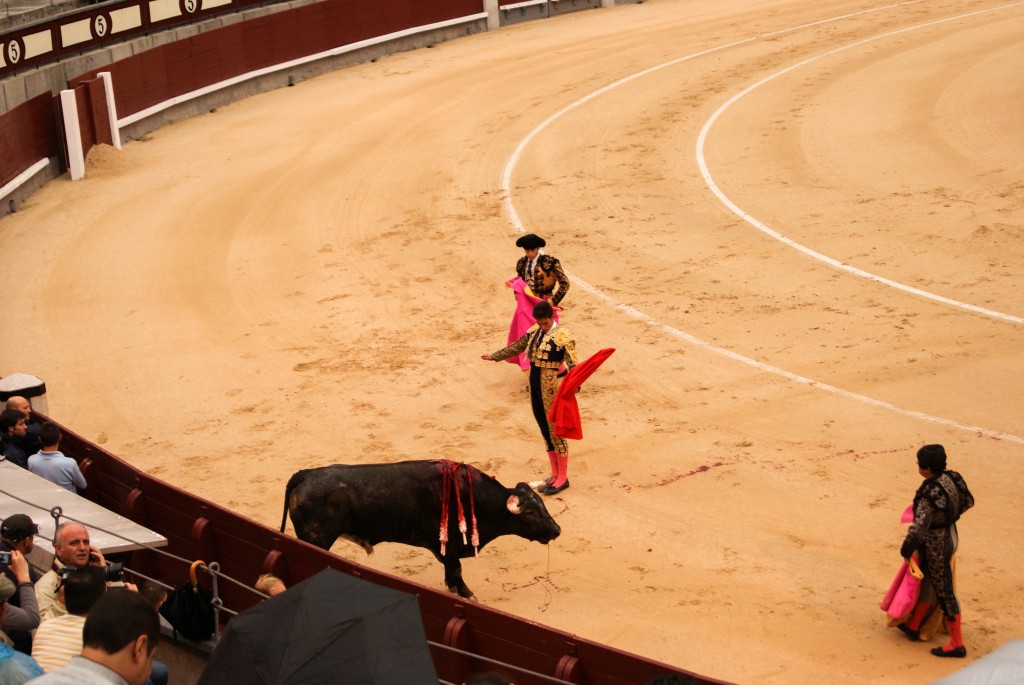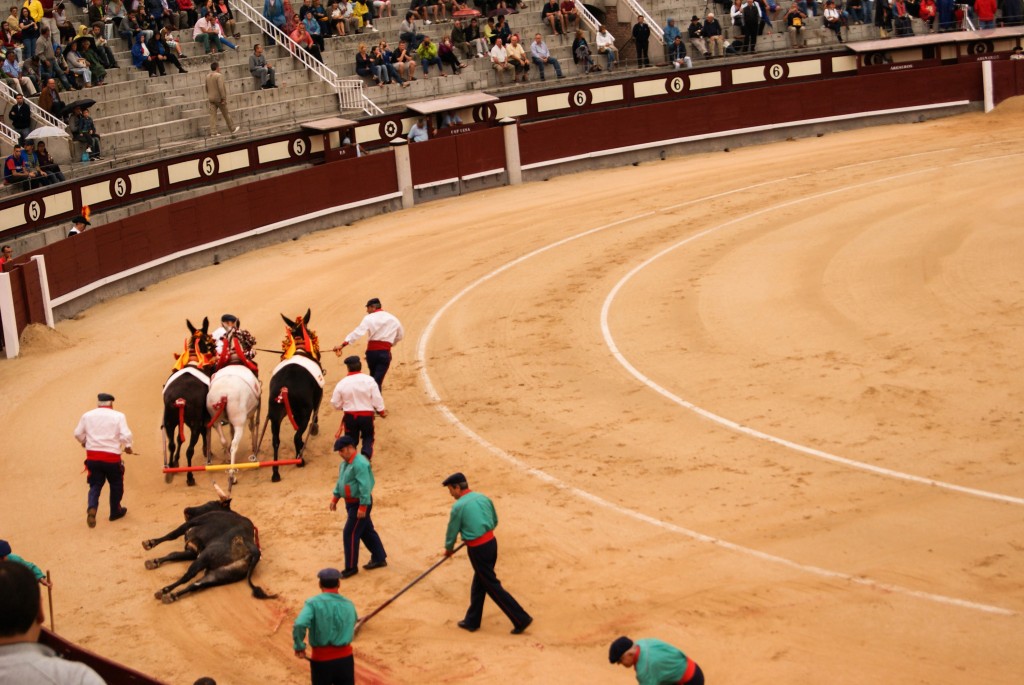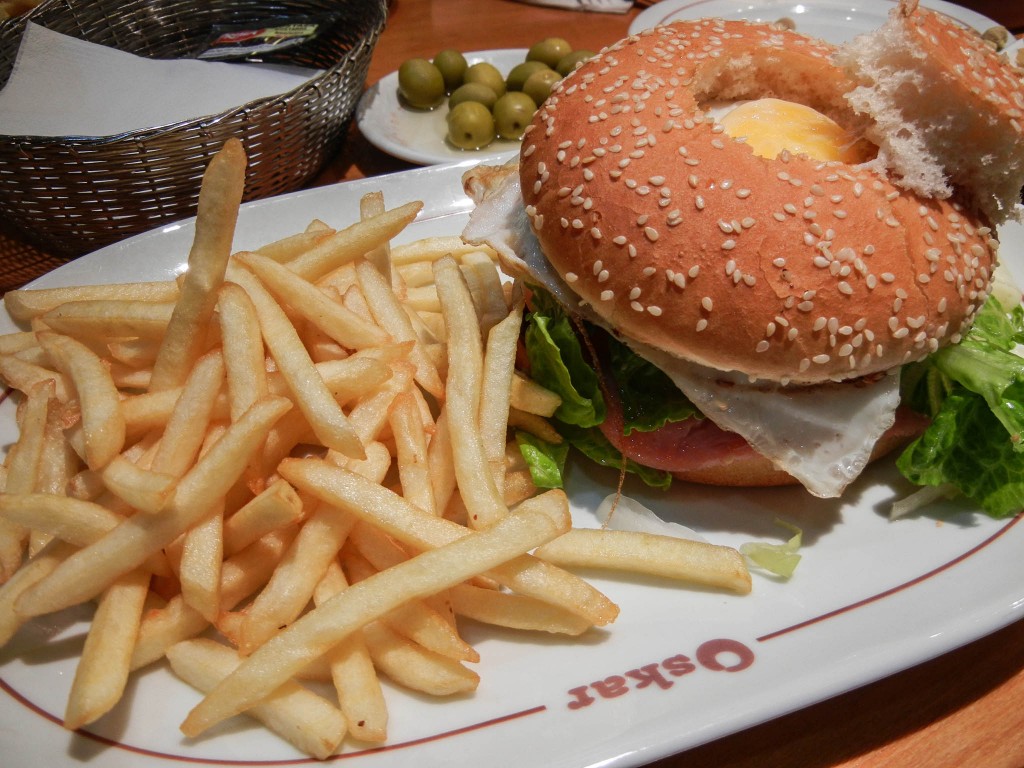They say that if the conditions are right and you are close enough to the ring, you can smell the blood being spilled at a bullfight in Spain. Certainly the gruesome and violent nature of this centuries-long Spanish tradition has been condemned by animal rights activists internationally and has even prompted the Spanish province of Catalonia to outlaw the sport all together. However the sport endures, especially in the southern region of Andalucía and in Madrid.
Plaza Mayor, Madrid
It was mostly curiosity that compelled us to buy tickets to a bullfight at Madrid’s legendary Las Ventas bullring. Admittedly, we were also swept up in the romantic idea of attending a bullfight in Spain. Visions of passionate crowds yelling “olé” in unison as brave and daring toreadors in gleaming costumes waved colorful capes in the air seemed to distract from the fact that the bulls were there to be killed. This fact only became more and more clear in the days leading up to the bullfight. Proponents of bullfighting defend the sport as a wholly invaluable cultural practice that has defined Spanish culture around the world. While the iconic status of the toreador cannot be denied, one must ask if this is worth the lives of innocent animals. To go even further, do the Spanish people want to be known as a culture that celebrates the slaughter of animals for entertainment? Pushing aside these conflicting feelings was not easy but necessary if I wanted to remain objective. So on a drizzly Sunday afternoon in late September, we caught the metro to Las Ventas, hoping to be enlightened, but anticipating sadness.
Bullfighting in Spain generally takes place on Sunday evenings from mid-spring to early autumn. We were fortunate to be in Madrid for one of the last corridos of the season. We climbed the stairs, away from the dark, humid metro and emerged to stand in front of the brilliant Las Ventas bullring, widely regarded as the “Madison Square Garden” of all bullrings, where only the best bullfighters have the privilege of performing. The graceful arches and mosaic details of the building helped establish an undeniable sense of place. It felt as if we were in the inner most chamber of the heart of Spain. I expected to see tourists, like us, lured to the bullring out of morbid curiosity. But there were also older Spanish gentlemen who looked as if they had been coming to bullfights their entire lives. There were families with kids, young couples and even bands of old ladies with colorful umbrellas. Once inside the bullring, our anticipation was almost palpable but tinged with a tiny bit of fear.
Royal Box at Las Ventas
One of our friends must have felt much like Hemingway; he quickly bought himself a cigar, a plastic poncho and a comfy leather seat cushion. Smart man. Later on, the rest of us wrestled with feelings of envy as our concrete seats became more and more arduous. Even I envied his cigar—I don’t normally smoke, but it just seemed so appealing given the circumstances. Our seats were in row 9, in the shade—not that it mattered much given the increasing clouds overhead. Halfway through, it started raining—not just raining, but pouring. Plastic ponchos were acquired, beers were bought and all of a sudden we didn’t seem to mind the rain so much. The crowds started moving to the upper levels that were actually covered. Not us though; we remained in our seats, huddled in our clear plastic vaquerors ordering beer after beer. By the way, 2.50EUR for a beer brought to your seat at a sports venue—amazing.
Bullfighters in traditional garb
The band started playing and the crowd started cheering as the toreadors, horses, picadors and others slowly marched in a neat line around the entire ring. The spectacle certainly felt as if we had been transported back in time, and in fact little has changed since bullfighting began in Spain around the 1730s. It is said that the bullfighting tradition actually stems from ancient animal sacrifices buried long ago in Spain’s past. The costumes, music and orderly parade around the bullring certainly made an impression; I felt as though I was watching something hundreds of years in the making. This warm feeling disappeared as soon as the first bull entered the ring.
One on one. Photo by Lauren Hill.
Traditionally, the matador is accompanied by three other bullfighters who serve as his backup and are called banderilleros. Their job is to taunt the bull with bright yellow and pink capes. This is done to show the bull’s furious nature to the crowd. Next, two picadors on horseback circle the bull and attempt to stab the bull’s neck with a lance when it charges. Their horses are equipped with special armor so that they are not injured by the bull. However, it was not until the 1930s that using horse armor became normal practice. We couldn’t help but feel bad for them since the bull would always try to gore each horse with impressive horns, creating a surprisingly loud and frightening crash. We also noticed that the horses, along with being encased in armor, were also blindfolded. Surely no horse would walk into the ring if he knew what was awaiting him! Once the picadors cleared out, the banderilleros returned and proceeded to attempt to plant two banderillas into the bull’s shoulder. Banderillas are sticks with a sharp hook at one end and handles decorated in colorful tissue paper. They are designed so that once they are implanted into the bull’s flesh they do not come out, and they cause the bull to bleed. Usually only one banderilla is successfully implanted at a time, but sometimes banderilleros are able to implant two simultaneously in a daring double-handed move.
At this point, the matador—the one charged with actually killing the bull—carried in a red cape and sword and was left alone with the bull. This, I believe, is the stage where proponents of the sport would say glory and art can be found.
An intense silence overcomes the audience as everyone focuses on the two figured in the ring. There is just something so primal about a fight between man and beast. The bullfighter is admired for his daring courage and the bull is admired for his awesome ferocity. The bullfighter swings his cape around gracefully; all movements are deliberate, calculated and cautious. Unlike before where the bull had to contend with three other bullfighters, he is now squarely concentrated on the single matador. In a short time, we see the matador and bull develop a relationship of give and take. The matador by now has summed up the bull’s abilities and temperament, carefully judging how close he can get to the bull. Meanwhile, the bull is a mass of pain, energy and fury. He stares at the matador, not moving a muscle, focusing, concentrating on the movement of the red cape (bulls are actually color blind) and in a sudden burst of power, charges. This fleeting moment causes everyone in the bullring to gasp in sheer terror and then immediately sigh in relief as the matador expertly moves his body out of the way and maneuvers the red cape in front of the bull. “Olé!” the crowd joyously cheers.
Nearing the end
Those few thrilling seconds were what everybody was waiting for. All of a sudden people were on their feet, watching with intense concentration what was unfolding in the ring. After a few more passes, the bull collapsed to the ground, too weak to continue. At this point, the bullfighter ended it all with a quick and lethal stab between the shoulder blades into the heart or spinal cord. Five bulls were killed that night in much the same way.
The bloody gruesome end
Over the course of the evening, one matador was gored and sent to the infirmary with serious injuries. At the end of the night, as we were leaving the ring we passed by the infirmary and read a posting on the wall detailing his injuries. The bull had gorged his thigh and tossed him around like a rag doll. He suffered a torn Achilles tendon, extensive ligament and muscle damage to his leg and of course massive bleeding. He was in serious condition, but was expected to recuperate. He was 20 years old. We left the bullring through a back exit where all the horses were being loaded into trucks. The rain had stopped and the sky had started to clear, revealing a silvery blue moon. As we walked out, the sharp, musty smells of the stables reminded us, along with the injury report we has just read, that the bullfight was real—there is nothing fabricated about this sport. Five animals died and one man was seriously injured. Despite this realization, I think we were all too caught up in the moment to fully appreciate the consequences of that night. As we ambled through the dark, damp night we suddenly realized that we were ravenous.
“What do you guys want to have for dinner tonight?”
“Steak.”
No steak, we went for burgers instead. They were great, with a fried egg and a peek-a-boo window in the bun.
Oskar burger with fries.
What are your thoughts on bullfighting? Is it a barbaric and cruel practice that is rightfully ending? Or is it important to retain cultural traditions? Let us know in the comments section, or on our Facebook and Twitter pages!
